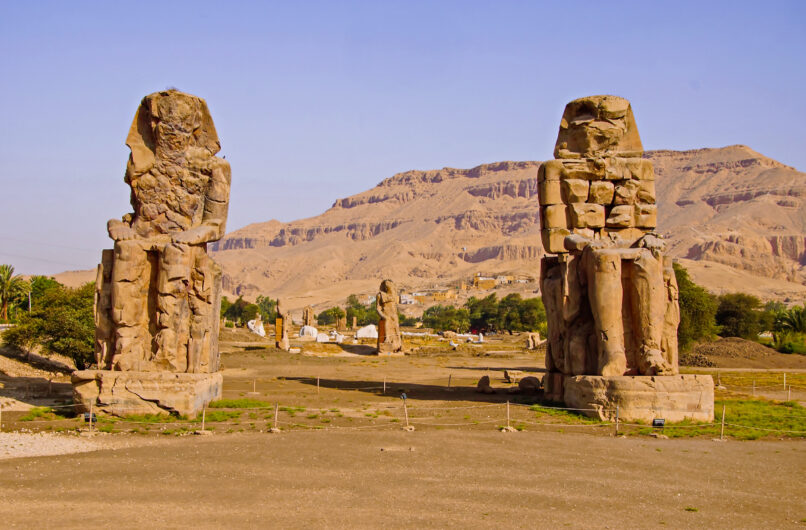
The Colossi of Memnon: Guardians of Ancient Thebes
Welcome to the awe-inspiring world of the Colossi of Memnon. Standing tall on the western bank of the Nile River near the city of Luxor, Egypt, these magnificent statues have captured visitors’ imaginations for centuries. In this comprehensive guide, we will delve into the rich history and significance of the Colossi of Memnon, exploring their origins, legends, and the mysteries they hold.
Unveiling the Colossi of Memnon
The Guardian Statues of Amenhotep III
The Colossi of Memnon are two massive stone statues depicting Pharaoh Amenhotep III, who reigned during the 14th century BCE. Initially, the statues were part of a grand mortuary temple dedicated to the pharaoh on the west bank of Thebes (modern-day Luxor). These imposing guardians stood at the entrance of the temple, welcoming visitors and symbolizing the power and divinity of Amenhotep III.
Colossi of Memnon Towering Structures
Each colossus measures approximately 18 meters (60 feet) in height and is carved from a single block of quartzite sandstone. The statues depict the pharaoh seated on his throne, with a serene expression and a regal presence. Despite the damage caused by natural disasters and the passage of time, the Colossi of Memnon continue to impress with their sheer size and remarkable craftsmanship.
Ancient Restorations and Legends
Over the centuries, they have endured numerous transformations. After suffering significant damage from an earthquake in 27 BCE, the statues were restored by the Roman Emperor Septimius Severus. It is believed that during this restoration, the statues produced haunting sounds at dawn, attributed to the mythological figure of Memnon, son of the goddess Eos. These “singing” statues became the source of legends and attracted pilgrims and travelers from far and wide.
Exploring the Legends (Colossi of Memnon)
The Myth of Memnon
According to ancient Greek mythology, Memnon was a hero and warrior who fought in the Trojan War. When Achilles, the goddess Eos, killed him, his mother pleaded with Zeus to grant him immortality. Zeus gave her request and transformed Memnon into a statue, brought to life every morning by the rising sun’s rays. The “singing” of it was believed to be the sound of Memnon greeting his mother.
Visitors of The Colossi of Memnon and the “Musical” Experience
The legends of the singing statues attracted numerous visitors throughout history. Ancient travelers and explorers, including Strabo and Pausanias, sought to witness the remarkable phenomenon. However, after an extensive restoration in the 3rd century CE, the statues ceased producing melodic sounds, likely due to structural changes caused by the repairs.
Frequently Asked Questions (FAQs)
Can visitors still see the Colossi of Memnon today?
Yes, the Colossi of Memnon are open to the public and can be visited as part of the West Bank of Luxor tours.
Are there any nearby attractions to visit along with the Colossi of Memnon?
Absolutely! They are close to other famous ancient sites, including the Valley of the Kings, the Temple of Hatshepsut, and the Ramesseum.
Can visitors climb the Colossi of Memnon?
No, climbing the Colossi of Memnon is strictly prohibited to ensure their preservation and the safety of visitors.
Is there an admission fee to see the Colossi of Memnon?
There is an admission fee to enter the site where they are located. The payment may vary depending on the specific tour or package you choose.
Are there any accommodations and facilities near the Colossi of Memnon?
Yes, various hotels, restaurants, and amenities are available in the nearby city of Luxor, providing visitors with comfortable accommodations and convenient services.
Conclusion
The Colossi of Memnon stand as magnificent reminders of Egypt’s ancient past. With their towering presence and rich history, these statues continue to captivate and inspire visitors worldwide. From the legends of their “singing” to their role as guardians of the mortuary temple, it offer a glimpse into the power and grandeur of the pharaohs of ancient Egypt.
As you stand before these colossal statues, allow yourself to be transported back in time, imagining the splendor and reverence with which they were once regarded. The Colossi of Memnon are not merely stone figures but enduring symbols of a civilization that left an indelible mark on the world.
- July 6, 2023
- 718
- Luxor Attractions
- 0 comment
